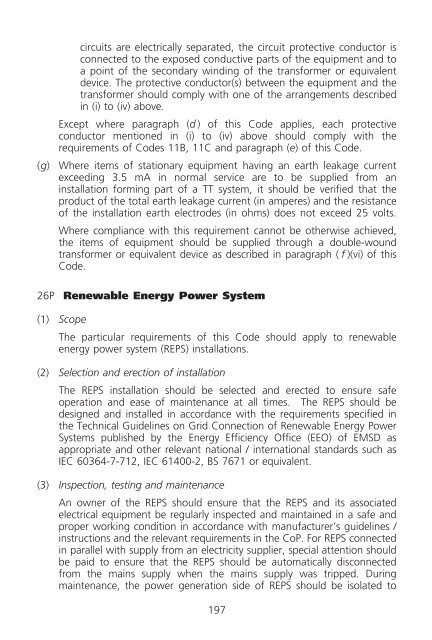Code of Practice for the Electricity (Wiring) Regulations - 2009 Edition
Code of Practice for the Electricity (Wiring) Regulations - 2009 Edition
Code of Practice for the Electricity (Wiring) Regulations - 2009 Edition
Create successful ePaper yourself
Turn your PDF publications into a flip-book with our unique Google optimized e-Paper software.
circuits are electrically separated, <strong>the</strong> circuit protective conductor is<br />
connected to <strong>the</strong> exposed conductive parts <strong>of</strong> <strong>the</strong> equipment and to<br />
a point <strong>of</strong> <strong>the</strong> secondary winding <strong>of</strong> <strong>the</strong> trans<strong>for</strong>mer or equivalent<br />
device. The protective conductor(s) between <strong>the</strong> equipment and <strong>the</strong><br />
trans<strong>for</strong>mer should comply with one <strong>of</strong> <strong>the</strong> arrangements described<br />
in (i) to (iv) above.<br />
Except where paragraph (d ) <strong>of</strong> this <strong>Code</strong> applies, each protective<br />
conductor mentioned in (i) to (iv) above should comply with <strong>the</strong><br />
requirements <strong>of</strong> <strong>Code</strong>s 11B, 11C and paragraph (e) <strong>of</strong> this <strong>Code</strong>.<br />
(g) Where items <strong>of</strong> stationary equipment having an earth leakage current<br />
exceeding 3.5 mA in normal service are to be supplied from an<br />
installation <strong>for</strong>ming part <strong>of</strong> a TT system, it should be verified that <strong>the</strong><br />
product <strong>of</strong> <strong>the</strong> total earth leakage current (in amperes) and <strong>the</strong> resistance<br />
<strong>of</strong> <strong>the</strong> installation earth electrodes (in ohms) does not exceed 25 volts.<br />
Where compliance with this requirement cannot be o<strong>the</strong>rwise achieved,<br />
<strong>the</strong> items <strong>of</strong> equipment should be supplied through a double-wound<br />
trans<strong>for</strong>mer or equivalent device as described in paragraph ( f )(vi) <strong>of</strong> this<br />
<strong>Code</strong>.<br />
26P Renewable Energy Power System<br />
(1) Scope<br />
The particular requirements <strong>of</strong> this <strong>Code</strong> should apply to renewable<br />
energy power system (REPS) installations.<br />
(2) Selection and erection <strong>of</strong> installation<br />
The REPS installation should be selected and erected to ensure safe<br />
operation and ease <strong>of</strong> maintenance at all times. The REPS should be<br />
designed and installed in accordance with <strong>the</strong> requirements specified in<br />
<strong>the</strong> Technical Guidelines on Grid Connection <strong>of</strong> Renewable Energy Power<br />
Systems published by <strong>the</strong> Energy Efficiency Office (EEO) <strong>of</strong> EMSD as<br />
appropriate and o<strong>the</strong>r relevant national / international standards such as<br />
IEC 60364-7-712, IEC 61400-2, BS 7671 or equivalent.<br />
(3) Inspection, testing and maintenance<br />
An owner <strong>of</strong> <strong>the</strong> REPS should ensure that <strong>the</strong> REPS and its associated<br />
electrical equipment be regularly inspected and maintained in a safe and<br />
proper working condition in accordance with manufacturer’s guidelines /<br />
instructions and <strong>the</strong> relevant requirements in <strong>the</strong> CoP. For REPS connected<br />
in parallel with supply from an electricity supplier, special attention should<br />
be paid to ensure that <strong>the</strong> REPS should be automatically disconnected<br />
from <strong>the</strong> mains supply when <strong>the</strong> mains supply was tripped. During<br />
maintenance, <strong>the</strong> power generation side <strong>of</strong> REPS should be isolated to<br />
197














